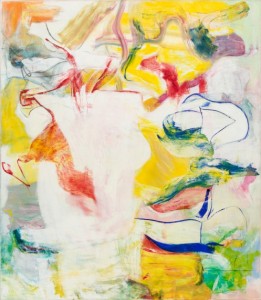The Heart of Abstract Expressionism
De Kooning is the most demanding of all the abstract expressionists. In a way that isn’t the case with Pollock or Rothko or Still or Motherwell—insert name here—de Kooning’s work always seems a bit confrontational. It’s as if someone who doesn’t have your best interests in mind (or maybe just doesn’t care that you’re there) has entered the room, and it might be best to keep an eye on him. This is a natural human reaction to an unpredictable presence, and de Kooning was never predictable. His work never settles down and behaves. You could forge a Rothko or Pollock or Motherwell without too much guesswork, really: their brilliance was in their invention of their own recognizable style, with a set of personal rules one can extrapolate pretty reliably from any of their great paintings. From then on, they worked out the consequences of their particular niche, with great consistency. It’s hard to imagine de Kooning had any sense of his own style, as such, nor did he seem to care much about how one of his paintings would look in the end. Once he began a painting, his only concern seemed to be to leave behind something that doesn’t just sit there—to reach the point where he could finally quit working on a canvas, stand back, and say, OK. It’s doing things on its own now. Let’s move on. It was all visceral, muscular, hand-eye, with the intellect in sleep mode: as Susan Sontag quotes him in an epigraph: Content is a glimpse of something, an encounter like a flash. It’s very tiny–very tiny, content. It would have been more honest to say, Content? There isn’t any. It’s all about the paint.
The big retrospective of de Kooning’s work at MoMA offers an opportunity to see how his work represents the essence of abstract expressionism, the heart of the movement, and you can see echoes of his continuous risk-taking and discovery more in the next generation, in Frankenthaler and Sam Francis, for example, than in the work of anybody in de Kooning’s crew. (It also happens to demonstrate, once again, that abstract expressionism originated with Gorky. You can see how clearly De Kooning pretty much impersonated Gorky for a while, as Pollock also did, before he became himself.) I began to warm up to de Kooning when I could see his paintings not as the conclusion of a plan, but as an artifact left behind by his endless attempts to discover a way forward after making an initial mark. His genius was that he never quite figured this out, once and for all, never really developed a technique or method for building the tensions that seem to hold his images together: every canvas was a fresh start, a new plunge into the unknown. Everything he did still seems risky. As a result, his work has a tactless quality—as if each painting is too self-absorbed to at least glance at itself in a mirror once or twice before heading to the gallery. The point wasn’t to please, but to instigate something that had a life of its own, regardless of how it all looked in the end. Many of his paintings happen to be dazzling, but in de Kooning’s case, it wasn’t by design. That just wasn’t the point.

I get that an abstract painting can be what you say art in general should be – just there, non-verbal, a slice of primal being. (I think that’s what you’re saying.)
But if an abstract doesn’t excite your senses, if it doesn’t feel like anything, then it’s unapproachable.
I literally stared at that de Kooning for awhile, trying to get it, but all I could think is the cliche that if it turned out to be a painting by a first-grader I wouldn’t be surprised.
I run into this a lot with friends who aren’t artists, including people who love painting. Twentieth century art still puzzles many people, especially abstraction. It’s a fundamental issue, and it makes me wonder if those of us who paint, and who love so much abstraction, have drunk the Kool-Aid and don’t know it. Tom Wolfe wrote The Painted Word in response to what had happened in the art world of the 50s and 60s, and his skepticism about abstract expressionism reflected how many people still respond to it. I want to write a long post about this whole issue and how I think it has a bearing on how marginalized visual art has become. I sometimes wonder if an artist needs to ask a simple question when he or she is done: “Do I really want to look at this? For how long? How many times do I want to go back and look again?” Is the work seductive and intriguing or does it push you away? Make that the starting point and build your theories to explain why, rather than the other way around–building the work from a pre-determined theory of what art should be.